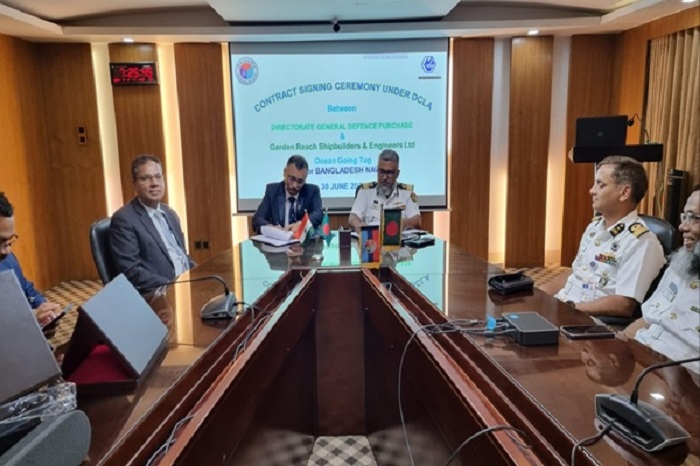
Garden Reach Shipbuilders and Engineers to Build Ocean-Going Tug for Bangladesh Navy » Capital News
New Delhi, July 9 – Earlier this week, the Bangladesh Navy signed a deal with India’s Garden Reach Shipbuilders and Engineers (GRSE) to build an 800-tonne ocean-going tug. This major contract is part of a $500-million line of credit offered to Bangladesh by New Delhi for the purchase of defence equipment.
The agreement was signed on June 30 in Dhaka by representatives of the Bangladesh Navy’s Directorate General of Defence Purchases and GRSE. The signing coincided with a four-day visit by Indian Navy Chief, Admiral Dinesh K. Tripathi, aimed at bolstering bilateral defence ties and exploring new avenues for naval cooperation.
The tug, worth approximately $21 million, will be delivered to Bangladesh within 24 months, according to the contract.
India has been actively expanding its defence foothold in foreign markets, including Bangladesh. Last month, GRSE signed an agreement with Germany’s Carsten Rehder Schiffsmakler and Reederei GmbH & Co to build four multi-purpose vessels of 7,500 DWT each. GRSE has previously exported an offshore patrol vessel and a fast patrol vessel to Mauritius and Seychelles, respectively.
In February, a senior official from Mumbai’s Mazagon Dock Shipbuilders Ltd. (MDSL) highlighted the significant market potential for Indian shipbuilding in Europe, France, Greece, and the Middle East over the next five years. India hosts 52 major shipbuilding industries, including both public and private units, and accounts for about 20 percent of the global market demand for commercial vessels.
According to a 2022 report by the Press Trust of India (PTI), Defence PSU GRSE, which built three advanced stealth frigates under Project 17A for the Indian Navy, is currently making seven vessels for foreign countries. The Kolkata-based shipbuilder is constructing six patrol boats for Bangladesh and an ocean-going cargo ferry vessel for the Cooperative Republic of Guyana.
The transformation of India’s naval shipbuilding capability has been a recurring theme in Indian maritime discussions. Since the 1960s, when the Union Ministry of Defence (MoD) acquired several shipyards and decided to build Leander-class frigates at the Mazagaon Dock Ltd (MD) in Mumbai, the Indian Navy has invested in developing an indigenous shipbuilding ecosystem.
Over the years, India’s naval ship production has made steady progress, significantly contributing to fulfilling the Navy’s shipbuilding requirements. India aims to secure more overseas deals to export “Made in India” vessels to foreign nations.
According to a report by The Maritime Executive published in November last year, India signed a deal to build 24 river-sea class cargo ships for Russia by 2027. The Russian shipbuilding sector has been severely impacted by Western sanctions due to the ongoing war in Ukraine. These 24 ships, including chemical carriers, bulk carriers, and container ships, will be constructed at the state-owned Goa shipyard.
The Indian government has announced plans to expand its shipbuilding sector, aligning with Russia’s needs. Senior Russian officials have confirmed that the 24 ships being built in the Indian shipyard will support Russia’s struggling shipbuilding industry.
Earlier this week, senior Indian government officials announced that the country’s shipping ministry will soon introduce a new shipbuilding and repair policy under the 100-day action plan. The Maritime India Vision 2030 (MIV 2030) aims to position India among the top 10 globally in shipbuilding and ship repair, while the Amrit Kaal Vision 2047, part of Prime Minister Modi’s vision for ‘New India,’ sets an even more ambitious goal of reaching the top five.
The Union Ministry of Ports, Shipping, and Waterways (MoPSW) has stated that this strategic vision reflects the Indian government’s commitment to transforming India into a global maritime powerhouse. This ambitious goal is part of a comprehensive strategy to enhance the country’s maritime infrastructure and capabilities.
